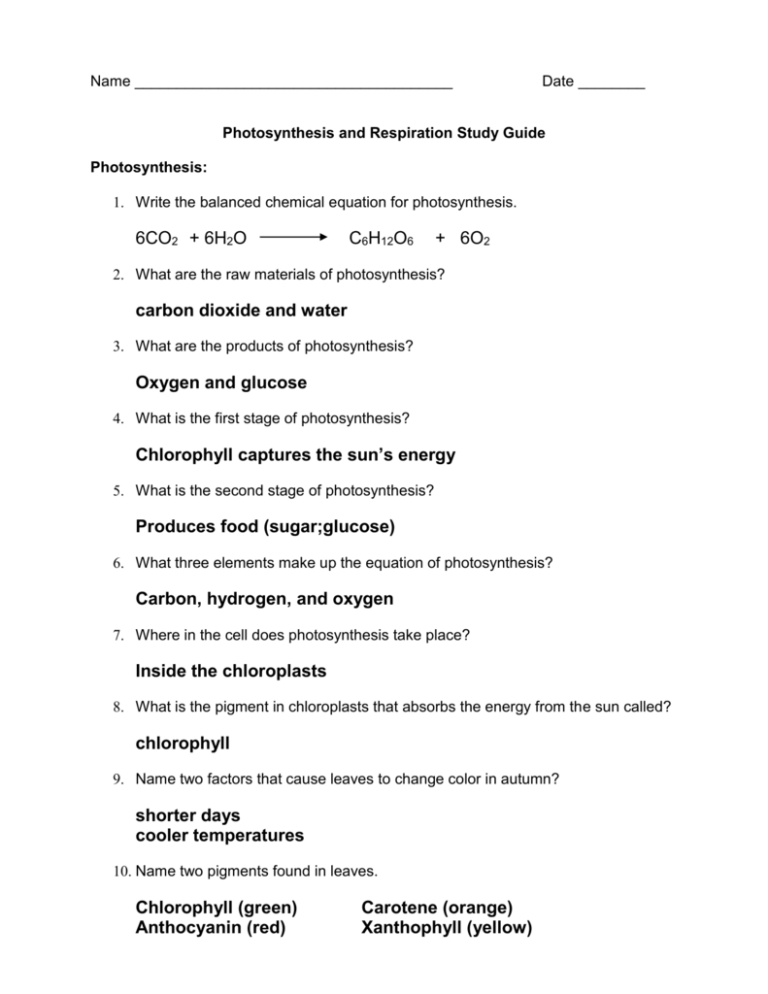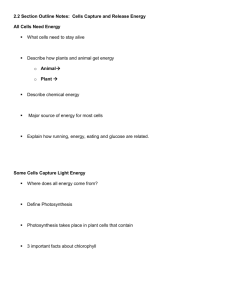Photosynthesis and Respiration
advertisement

Name ______________________________________ Date ________ Photosynthesis and Respiration Study Guide Photosynthesis: 1. Write the balanced chemical equation for photosynthesis. 6CO2 + 6H2O C6H12O6 + 6O2 2. What are the raw materials of photosynthesis? carbon dioxide and water 3. What are the products of photosynthesis? Oxygen and glucose 4. What is the first stage of photosynthesis? Chlorophyll captures the sun’s energy 5. What is the second stage of photosynthesis? Produces food (sugar;glucose) 6. What three elements make up the equation of photosynthesis? Carbon, hydrogen, and oxygen 7. Where in the cell does photosynthesis take place? Inside the chloroplasts 8. What is the pigment in chloroplasts that absorbs the energy from the sun called? chlorophyll 9. Name two factors that cause leaves to change color in autumn? shorter days cooler temperatures 10. Name two pigments found in leaves. Chlorophyll (green) Anthocyanin (red) Carotene (orange) Xanthophyll (yellow) 11. What kind of trees loose their leaves in autumn? deciduous trees (the broadleaf trees) 12. Name the process used to separate the various pigments in leaves. Paper chromatography 13. What is an autotroph? Give two examples. An organism that makes its own food (self-feeder). Ex. Rose, lily, oak tree 14. What is a heterotroph? Give two examples. An organism that can not make its own food. Ex. bird, caterpillar, human 15. Why is the sun important to all living things? The sun is necessary for photosynthesis. This is how plants make their food. The process makes the oxygen that organisms need to breathe and to use in respiration. The process keeps the plants alive and this is important not only for the oxygen they produce, but as a food source for many animals. If there was no sun, there would be no plants and subsequently there would be no animals. 16. What process is responsible for producing most of the Earth’s oxygen? photosynthesis 17. What are the tiny openings on the undersides of leaves that control the movement of carbon dioxide, oxygen, and water vapor called? stomata 18. What are the cells that surround the tiny openings on the undersides of leaves called? guard cells Cellular Respiration: 19. Define cellular respiration. Process where cells breakdown simple food molecules such as glucose and release the energy they contain in their chemical bonds. 20. Where does the second stage of respiration take place in the cell? mitochondria 21. Name the three products of respiration. Carbon dioxide, water and energy (ATP) 22. What organisms undergo alcoholic fermentation? yeasts 23. Why is respiration important for a cell? It makes the energy that cells need to survive. 24. Explain the relationship between photosynthesis and respiration? They are opposite processes. During photosynthesis, carbon dioxide and water are used to make glucose and oxygen. During respiration, glucose and oxygen are used to make carbon dioxide and water, but respiration includes energy. 25. Which raw material is not needed for fermentation to occur? oxygen 26. What kind of fermentation takes place in your muscles when the cells do not have enough oxygen to produce energy? Lactic-acid fermentation 27. What is anaerobic respiration? Respiration that does not require oxygen (fermentation) 28. What is aerobic respiration? Respiration that requires oxygen.







